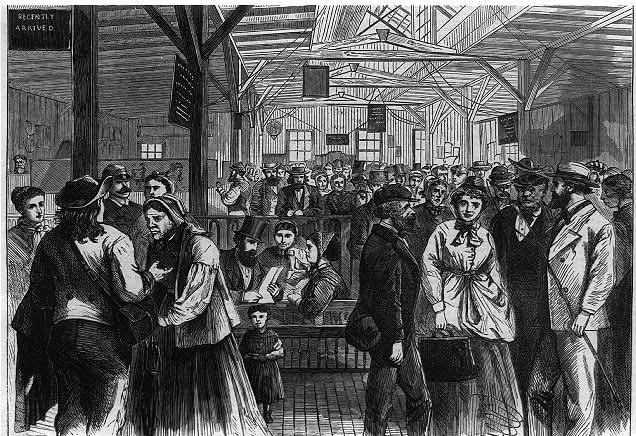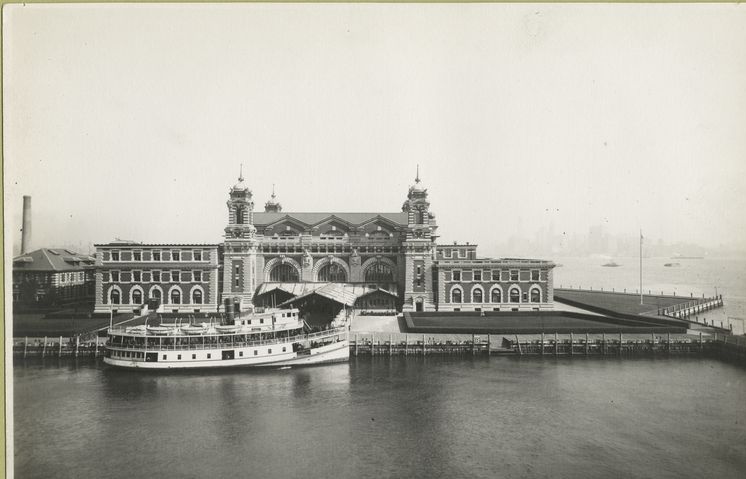|
By Laurie Lewis With immigration such a hot topic in recent years, a review of the history of immigration to America seems appropriate. We’ll focus on immigration through the great port city of New York, because after all, this is a newsletter about New York. Some 20 million people entered the country between the mid-1800s and mid-1900s through two locations in New York. Most people think of Ellis Island as the gateway to America in the days when immigrants crossed the Atlantic by ship. But before Ellis Island, there was Castle Garden. Immigrants at Castle Garden (From the National Park Service. Sketch by Stanley Fox.) Near the southern tip of Manhattan, Castle Garden (like Ellis Island) had been a military fortification built to defend New York Harbor during the War of 1812. It later became an entertainment center, most famous for showman P. T. Barnum’s introduction to American audiences of Jenny Lind, “the Swedish nightingale,” in 1850. Before and during the period when Castle Garden was an entertainment venue, each state was responsible for processing immigrants who arrived at its ports. By the middle of the nineteenth century, the number of new arrivals was growing rapidly, with most coming through New York Harbor. To help the throngs of immigrants, New York State turned Castle Garden into the nation’s first official immigration center. Workers connected the newcomers to licensed boarding houses and immigrant aid groups, and travelers going beyond New York City received tickets to their destination. From 1855 until 1890, 8 million immigrants passed through Castle Garden. Then the federal government took over responsibility from the states for processing immigrants. After two years with a makeshift processing center in New York, Ellis Island opened as the national immigrant station on January 1, 1892. The first person to go through the welcoming process was Annie Moore, a teenager from Ireland. More than 12 million newcomers passed through Ellis Island before it closed in 1954. The record year was 1907, when 1.25 million immigrants entered America at Ellis Island. By then the dominant groups were changing from northern Europeans to Italians and eastern Europeans. Ellis Island, with a boat carrying new arrivals in the early 1900s (From the New York Public Library digital collections. Photo by Edwin Levick.) According to the Statue of Liberty–Ellis Island Foundation, third-class and steerage passengers aboard the crowded steamships usually completed the inspection process in five hours or less. They had to pass a cursory medical exam and an inquiry by a legal inspector, who gave the go-ahead unless he thought the individual might become a burden to society. Only 2 percent of hopefuls were turned away at Ellis Island. By the time Ellis Island closed, plane travel had helped diminish the status of New York as the main point of entry to the United States. The point of origin of the immigrants also was different with passing years, with more people coming from Asia, Africa, and Latin America. The shift was due in part to changing immigration laws (see below). Today, too, the largest numbers of immigrants are from these parts of the globe. Both Castle Garden and Ellis Island continue to draw crowds, but they are visitors, not immigrants. To go to the Statue of Liberty or the Ellis Island Immigration Museum, visitors buy ferry tickets at the remains of the Castle Garden immigration center. Major U.S. Immigration Laws Illegal immigration rarely was a problem in the first 150 or so years of this country’s history because few immigration laws existed to be broken. The main barriers for taking up residence in the U.S. were against people who posed health risks, had committed serious crimes, or might become a financial burden. The earliest law barring immigration from a particular part of the globe was the Chinese Exclusion Act of 1882. Subsequent laws barred immigrants from other Asian countries. As more southern and eastern Europeans settled in America, Congress passed the Immigration Act of 1924. This was a blatant attempt to mold the makeup of the country by limiting the number of newcomers from certain places. The law created immigration quotas based on the origin of the U.S. population in the 1890 census. As a result, residents of Great Britain, Ireland, and Germany received 70 percent of all immigrant visas. The 1965 Immigration and Nationality Act generally did away with the quota system. Now family members and skilled workers from all countries were welcome to apply for an immigrant visa. Later laws offered protection to refugees fleeing violence or natural disasters. March Tours Most Take a Walk New York tours cover 1 to 2 miles, last 2 to 2½ hours, and cost $25 per person. Advance registration is required. To register and to learn the meeting place, email the guide ([email protected] or [email protected]). Please arrive a little before the start time. Tours are cancelled if nobody has registered or if the weather is extreme; if in doubt, call or text Laurie (917-306-2868) or Alan (917-363-4292). 400 Years of History in Less Than a Mile Lower Broadway is like an illustrated history textbook, with the pages out of order. This stretch of Manhattan reflects American history from colonial times to the present. Take a walk in the footsteps of George Washington and Alexander Hamilton. Hear stories about heroes like them as well as rogues like William “Boss” Tweed. Look at beautiful buildings, including the first department store. Alan gives this tour on Saturday, March 9, at 10 AM. Email him ([email protected]) to reserve your place and to learn the meeting location. Mansions of Fifth Avenue You can still find magnificent mansions built about a hundred years ago on the Upper East Side. These freestanding and rowhouse mansions are interspersed among luxury apartment buildings—mansions in the sky. Hear about these palatial homes and the people who lived in them—New York City’s own rich and famous. Laurie offers this tour on Friday, March 15, at 1 PM. To reserve a place on the tour and to learn the meeting location, email the guide at [email protected]. Central Park: Marvels of the Northern Half The northern end of Central Park features some of the city’s most surprising landscapes. Enjoy an early spring hike in the woods, and you’ll feel as though you’ve left the city. Discover New York’s own Secret Garden. If history rather than nature is your thing, fear not. You’ll learn about the role this area played in early American wars. Join Alan on Wednesday, March 20, at 11 AM to explore the northern part of Central Park. To reserve a spot and to learn where to meet, email him at [email protected]. Central Park: Highlights of the Southern Half In the southern half of the park, you’ll recognize some of the most filmed and photographed sights in New York, including Strawberry Fields, the Sheep Meadow, and Bethesda Terrace. Enjoy the scenic Lake and the wooded Ramble too. Join Laurie to explore the southern half of Central Park on Sunday, March 24, at 1 PM. Email her ([email protected]) to register and to learn the meeting location. March Tours
Comments are closed.
|
Archives
April 2024
|



